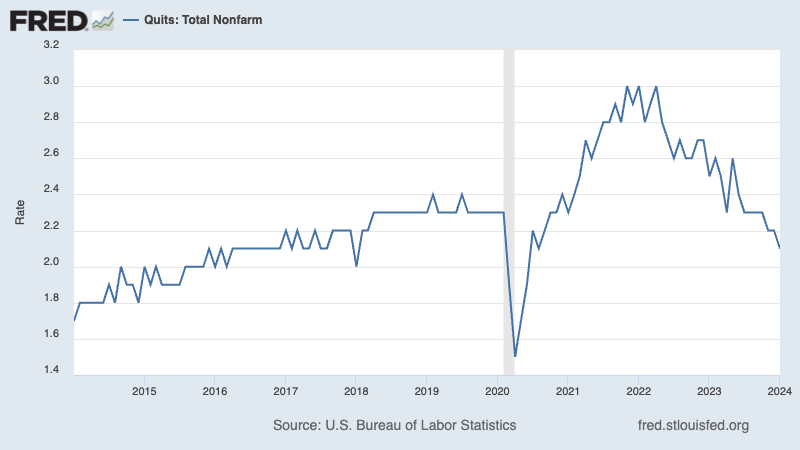Stocks made new record highs, with the S&P 500 setting a closing high of 5,157.36 on Thursday and reaching an intraday high of 5,189.26 on Friday. For the week, the S&P shed 0.3%. The index is now up 7.4% year to date and up 43.2% from its October 12, 2022 closing low of 3,577.03.
Productivity has been improving, and that’s a good thing. Not only does it mean employers are getting more output per worker, it also helps keep inflation tame. Better productivity is also good news for the stock market as it acts as a tailwind for profit margins, which is good for earnings growth and it may justify higher valuation premiums.
According to BLS data released Thursday, labor productivity increased 3.2% in the fourth quarter of 2023, the third straight quarter of gains. During the period, output increased 3.5% while hours worked increased by just 0.3%.
There are lots of reasons to explain why productivity might be improving.
Fewer Are Quitting
Less churn in the labor market is one reason. In January, 3.39 million workers quit their jobs. This represented just 2.1% of the workforce, which is below the prepandemic trend.
The quits rate has come down in the economy. FRED
“In the early days of the pandemic, labor markets were red hot, driving up the rate of quits and hires,” Renaissance Macro’s Neil Dutta wrote on Monday. “Employers were running around with fishnets trying to find people, and workers understood their leverage, quitting jobs in search of better paying ones. A little heat in the job market is good, but you can have too much of a good thing. It’s hard to establish productivity if folks are not actually staying in their positions for that long!”
That makes sense. When you’re new to a job, you’re probably spending a lot of time learning the ropes. The longer you stay in a job, the better you get at it.
Employment cost growth has been cooling with the quits rates. FRED
As Dutta previously observed, employment cost index growth and the quits rate peaked at about the same time two years ago and have been trending lower together ever since.
Upgrade to paid
There Are More New Businesses
The boom in new business formation may be another reason why productivity is improving.
According to monthly Census Bureau data, business applications and formations have been trending significantly above pre-pandemic levels.
There’s been a boom in new businesses. (Source: Census)
“That’s important since the slowing pace of business dynamism and lack of new business formation in the 2000s was said to be a reason behind the sluggish growth in productivity over that period, particularly after 2005,” Dutta wrote. “The rise in business formation suggests that people are willing to take on additional risk, and that’s probably important in lifting productivity.”
Indeed, some of the world’s most successful businesses were started by entrepreneurs who cut their teeth at legacy companies, only to leave because they saw an opportunity to execute more efficiently.
And poorly managed unprofitable businesses tend to layoff workers, while better managed profitable ones tend to hire.
“Productivity improves when resources are reallocated from less productive to more productive businesses,” Oxford Economics’ Ryan Sweet wrote on Tuesday.
The Advent Of AI
Of course, there’s also the rapid uptake of artificial intelligence (AI) technologies.
“There is a notable amount of overlap among the industries discussing operational efficiency most prevalently and those that have the potential to realize more significant AI-driven efficiency gains,” Morgan Stanley analysts wrote in February. “We see AI-driven productivity adding an additional 30 bps to 2025 net margin for the S&P 500 (13.0% net margin in the base case) though we believe risk is skewed to the upside/our bull case in this respect — 50 bps of added impact.“
But as the analysts note, it could be a little while before we realize significant tangible benefits from the adoption of AI.
Upgrade to paid
“The news media is littered with discussions about artificial intelligence and the resulting productivity boom,” Dutta said. “Just because there is a technological breakthrough, productivity miracles don’t necessarily follow right away. It takes time for the technology to make its way through the economy and time for workers to gain the skills needed to make the most use out of technological advances.“
Zooming Out
There isn’t a single metric that does a great job of explaining the state of productivity in the economy. Part of the issue is there are so many ways to think of productivity conceptually. As such, improved productivity manifests in many forms.
One thing I’m pretty confident of is that everyone wants everything and everyone else to be more productive. Employers want their workers and equipment to be more productive so their companies can be more profitable. Workers want to be more productive, and we’d all love to get more done with less time and effort.
At home, everyone wants to be more productive in all they do — because life is short, and who’s got the time? And being productive doesn’t necessarily mean being active all the time. A great vacation or a good night’s sleep can be productive if it makes you refreshed and energized, which in turn can make you more productive in your other activities.
All of these needs and desires incentive people and businesses to come up with new ways to be productive. And all of this is bullish for economic activity, earnings growth, and stock prices in the long run.
A version of this post was originally published on Tker.co.
© 2025 Benzinga.com. Benzinga does not provide investment advice. All rights reserved.
Trade confidently with insights and alerts from analyst ratings, free reports and breaking news that affects the stocks you care about.


